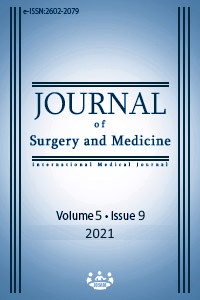Is this coccyx fractured, or is it a normal variant? A cohort study
Keywords:
Back Injuries, Coccyx, Spinal Injuries, Spinal FracturesAbstract
Background/Aim: The coccyx has several variants which could sometimes be confused with fractures. Our study aimed to alert physicians about the types of coccyges that can be easily confused with coccyx fractures in daily practice. Methods: Mid-sagittal and mid-coronal computerized images of 75 patients were analyzed to determine the types of coccygeal fracture, the coccyx types, number of segments, joint fusion, coccygeal bony spicules, subluxation, sacrococcygeal angle (SCA), intercoccygeal angle (ICA), and lateral deviation of the coccyx. Results: The mean age of the patients was 43.5 (13.6) years. There were 33 (44%) males and 42 (56%) females. While 57 (76%) patients were thought to have a coccygeal fracture, only 18 patients (24%) actually had them. There was a significant difference between the coccyx types mistaken for fractures and actual coccygeal fractures (P<0.001). Conclusion: It is essential to know the coccyx types and distinguish normal variants from fractures. If the difference between coccyx fractures and coccyx types is known and the patients are informed accordingly, both the loss of workforce decreases, and the necessary treatment can be started early.
Downloads
References
Woon JT, Stringer MD. Clinical anatomy of the coccyx: a systematic review. Clin Anat. 2012;25(2):158-67.
Lirette LS, Chaiban G, Tolba R, Eissa H. Coccydynia: an overview of the anatomy, etiology, and treatment of coccyx pain. Ochsner J. 2014;14(1):84-7.
Protzer L, Seligson D, Doursounian L. The coccyx in clinical medicine. Curr Orthop Pract. 2017;28(3):314-7.
Nathan S, Fisher B, Roberts C. Coccydynia: a review of pathoanatomy, aetiology, treatment and outcome. J Bone Joint Surg Br. 2010;92(12):1622-7.
Maigne J-Y, Doursounian L, Jacquot F. Classification of fractures of the coccyx from a series of 104 patients. Eur Spine J. 2019:1-9.
Grassi R, Lombardi G, Reginelli A, Capasso F, Romano F, Floriani I, et al. Coccygeal movement: assessment with dynamic MRI. Eur J Radiol. 2007;61(3):473-9.
Mitra R, Cheung L, Perry P. Efficacy of fluoroscopically guided steroid injections in the management of coccydynia. Pain Physician. 2007;10(6):775.
Gunduz OH, Sencan S, Kenis-Coskun O. Pain relief due to transsacrococcygeal ganglion impar block in chronic coccygodynia: a pilot study. Pain Med. 2015;16(7):1278-81.
Trollegaard A, Aarby N, Hellberg S. Coccygectomy: an effective treatment option for chronic coccydynia: retrospective results in 41 consecutive patients. J Bone Joint Surg Br. 2010;92(2):242-5.
Woon JT, Perumal V, Maigne J-Y, Stringer MD. CT morphology and morphometry of the normal adult coccyx. Eur Spine J 2013;22(4):863-70.
Marwan YA, Al-Saeed OM, Esmaeel AA, Kombar ORA, Bendary AM, Azeem MEA. Computed tomography–based morphologic and morphometric features of the coccyx among Arab adults. Spine. 2014;39(20):E1210-E9.
Przybylski P, Pankowicz M, Boćkowska A, Czekajska-Chehab E, Staśkiewicz G, Korzec M, et al. Evaluation of coccygeal bone variability, intercoccygeal and lumbo-sacral angles in asymptomatic patients in multislice computed tomography. Anat Sci Int. 2013;88(4):204-11.
Postacchini F, Massobrio M. Idiopathic coccygodynia. Analysis of fifty-one operative cases and a radiographic study of the normal coccyx. J Bone Joint Surg Am. 1983;65(8):1116-24.
Dennell LV, Nathan S. Coccygeal retroversion. Spine. 2004;29(12):E256-E7.
Kerimoglu U, Dagoglu MG, Ergen FB. Intercoccygeal angle and type of coccyx in asymptomatic patients. Surg Radiol Anat. 2007;29(8):683-7.
Shalaby SA, Eid EM, Allam O, Ali AM, Gebba MA. Morphometric study of the normal Egyptian coccyx from (age 1-40 year). Int J Clin Dev Anat. 2015;1(1):32-41.
Downloads
- 758 1795
Published
Issue
Section
How to Cite
License
Copyright (c) 2021 Serdar Toy, Alperen Zeynel, Kemal Zencirli
This work is licensed under a Creative Commons Attribution-NonCommercial-NoDerivatives 4.0 International License.
















